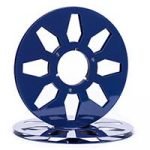MILES DAVIS KIND OF BLUE, HEMIOLIA RECORDS, REEL-TO-REEL REVIEW
HiFI PiG’s resident tape-head Alan McIntosh takes a listen to Miles Davis “Kind of Blue” on Hemiolia Records, 15ips 10.5” 2 track reel. CCIR EQ.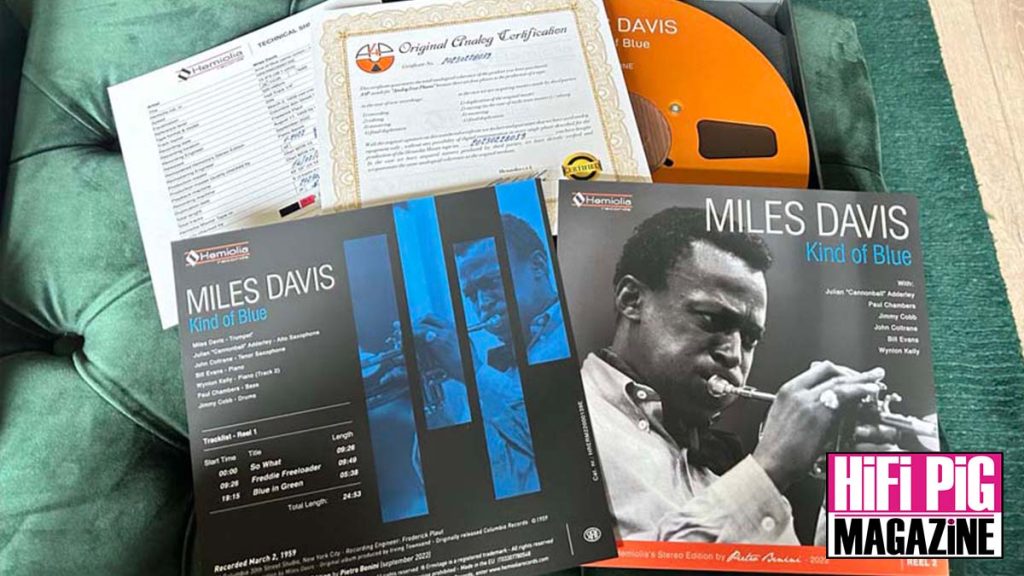
This review is best read following my previous one where I covered the Hemiolia release of John Coltrane’s “Blue Train”, as it covers elements of the recording medium, background, and technical information that I won’t bore you by repeating here. So pop off and read then come back. Off you go!
Back? Great then let’s get into Miles.
As Bill Evans writes in the original liner notes (I paraphrase), Miles had only provided the outline for what was to be played mere hours before they were recorded, the players had never played them prior and each recording that made it to the album was delivered pretty much as a “take” …and in that lies the spontaneity, the rawness and the utterly beautiful simplicity for what we hear today.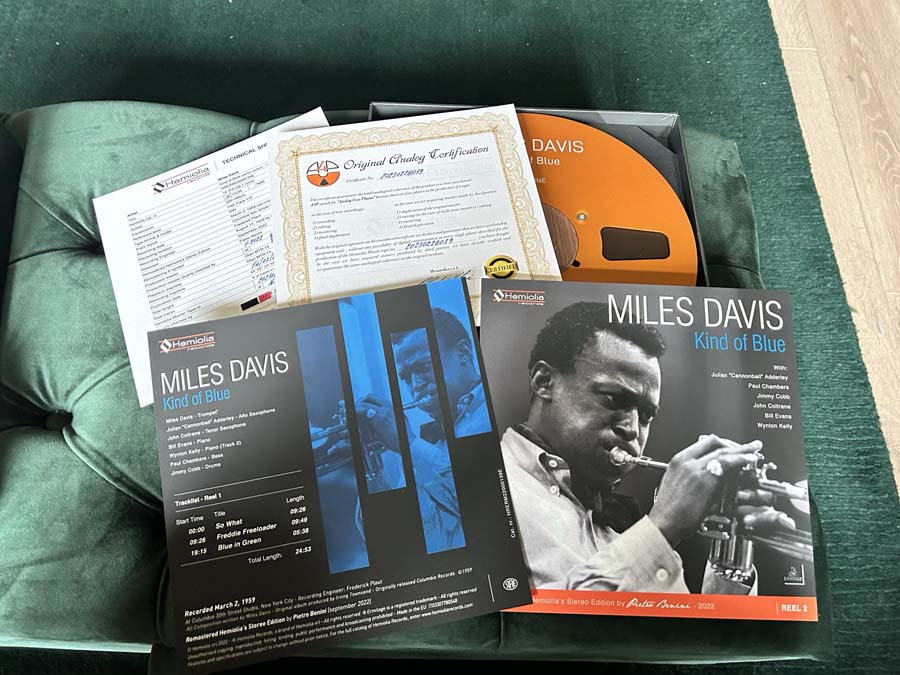
Kind of Blue hopefully needs no introduction, and I’m sure if you are reading this you have heard, if not own, at least one version – possibly multiple versions and perhaps on different media. Personally, I have a few including the Analogue Productions UHQR Vinyl – which I am using here to some extent as a reference and comparison. I want to be very clear before we proceed, however, this is purely to allow you as a reader to have a frame of reference – I will not offer definitive of which is best – I never do in my reviews and only ever my preferences at times. “Best” can to some be a simple matter of data and measurement (but versus what?), to others, let’s face it, it can be highly subjective and based on taste, hearing, room, system, and what mood you are in – unless you were at the recording or have heard the original master in your own system, it’s almost impossible to say with certainty how they merit (in my humble opinion of course)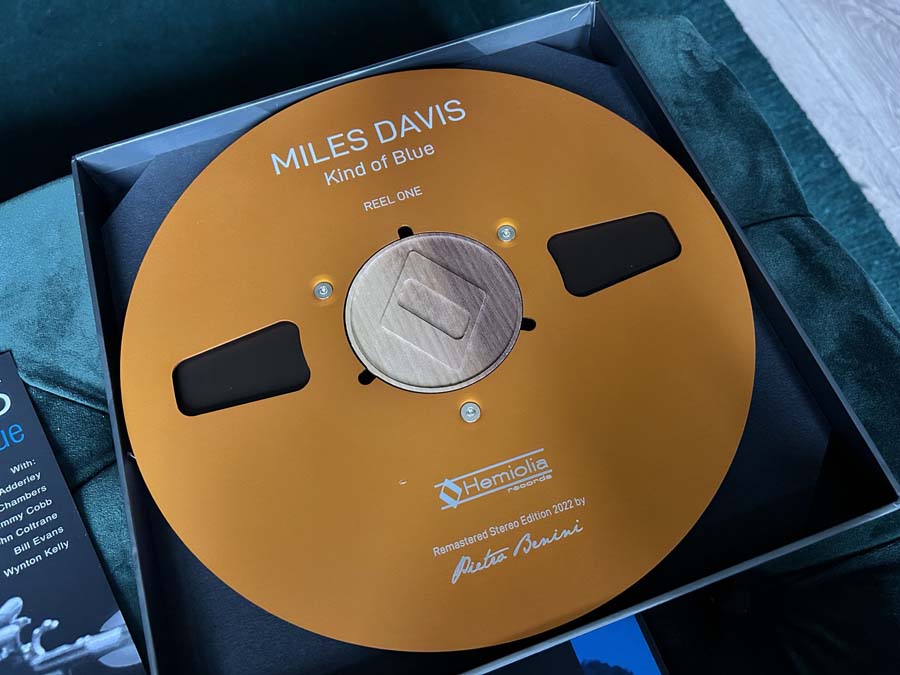
Originally recorded at Columbia’s 30th street studio in New York (on 3-track tape, as was common at the time), across 2 sessions in spring 1959 and then released in August of that year, it’s easy to see why many regard it as one of the best Jazz album ever recorded – it is certainly Miles’s “opus” work. Regardless of where it ranks in your own personal list, it’s inarguably a phenomenal price of work – not least due to the sextet of players that reads like a “who’s who” of modern jazz. With Miles leading, we have the dual giants of the saxophone – both John Coltrane and Julian “Cannonball” Adderley – we have wonderous piano work and also the obvious broad influence of Bill Evans (barring one track Freddie Freeloader– where Wynton Kelly is a very competent stand-in), Billy Cobb on drums and Paul Chambers in fine fettle on bass.
Leaving behind his trademark Hard Bop style and following his successful Milestone in 1958, Miles takes a fully modal approach to Kind of Blue, where each player is provided a scale to work within when taking their own solo or improvisation sojourns rather than providing exclusively a repeated chord base for the soloist to make progressive use of. This allows for great experimentation and a freer style for each player, but hangs the whole piece together within that modal range. This delivers a fresh and exciting experience for Davis’ fans, and Coltrane later adopts a more Mdal approach in his own works (see his quartet works from 1960 to 65) while Bill Evans has already become comfortable in Modal composition with “Peace Piece” on his 1958 Everybody Digs Bill Evans
To be able then to get my grubby mitts on a 2 track, 15ips Master Copy (fully licensed) of the jazz behemoth Kind of Blue is just phenomenal. (I paid for this pleasure out of my own pocket) . Packaged as with Blue Train in a lovely sturdy double thickness 10” reel box, Kind Of Blue cover art, and Hemiolia branding on the front, sealed in robust cellophane with a warranty sticker affixed. Opening the box is like diving into that artisanal box of chocolates you’ve been savouring, or bottle of high-end Single Malt whisky you’ve been saving for a special occasion – you slide the lid off gingerly, both eager to get in amongst it, but also tentative and reluctant to rush the experience.
Inside, atop the reels themselves, are lovely reprinted card inserts like mini LP covers (one for each tape/side of Kind of Blue), a technical certificate and a Certificate of Authenticity signed by Hemiolia. As with Blue Train, there are 2 beautiful burnt orange anodised aluminium reels secured on a rather lovely carved wooded “hub”. Adding to the already wonderful tactility of the tapes is the raised lettering on each reel bearing the title, tape number (1 and 2), and Hemiolia brand.
As with the Blue Train release, Hemiolia has (incredibly) licensed Kind of Blue to create this Master Copy release. Now, “Master Copy” is one of those terms that can be quite divisive among audiophiles so let me give my tuppence worth. For tape fans, Master Copy is an understood term to mean a range of specifics – it’s a tight range but its fluid to some extent. Master tapes in the context of remasters, reissues, and master copy tapes is (to me and others I know) an accepted and comfortable “catch-all” phrase to represent, interchangeably, the genuine studio master, safety copies, 1st gen remaster available copies and even session tapes or “takes”. Of course, we’d all love to feel we are hearing the “real thing” as it was recorded with only a few feet of microphone cable in the way, but it’s an accepted fact that you cannot offer the live studio master out willy-nilly to have loads of runs or of course it will deteriorate, or, god-forbid, get lost. There are cases of master tapes being sent out only to be lost in transit!
For anyone who works with and understands professional tape reproduction (I’m learning every day!) – using only very high-quality recorders, calibrated regularly to very specific tolerances, equalisations, and flux’, and using only brand new high-quality studio-grade, 2-track media – will be very comfortable with 1st generation copy tapes – neither you, me or your pet bat will hear the difference (verbose and probably inaccurate in the most technical of senses, but you know what I mean… it’s as close as is practically possible). 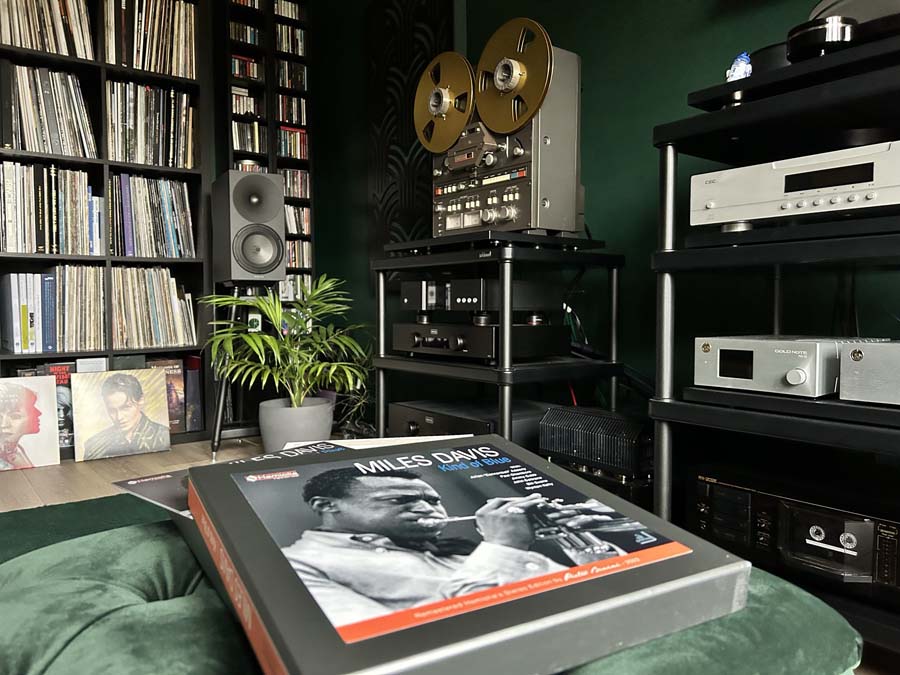
Therefore when a tape-head (sic) hears “Master Tape” they don’t get all hot and bothered with the semantics of “But that tape isn’t the REAL master, or “those tapes were lost in the Warner fire so this is b*llshit”. The reality of that particular case is that no one actually knows which specific tapes (studio, safety, session, takes, unreleased material) by which particular artists actually got lost or damaged (and I doubt we ever will – however if you do, dear reader, please share). Therefore if all master tape producers were all lying, and with the amount of scrutiny in the tape market today I would posit companies would get found out pretty fast (I can hear the cries of “DSD” as I type this…) – we all know suppliers of tape who are a little “questionable” but Hemiolia does not appear to be one of them. Which “master tape” was used here is unknown to me, but it has to be assumed to be at least very close to the original, as they are noted as being “Verified Masters”. Given its 3 -track origin, if Wikipedia is to be believed, at some point the Master was bounced down to 2 track. Hemiola’s process from there is all analogue – as certified in their documentation.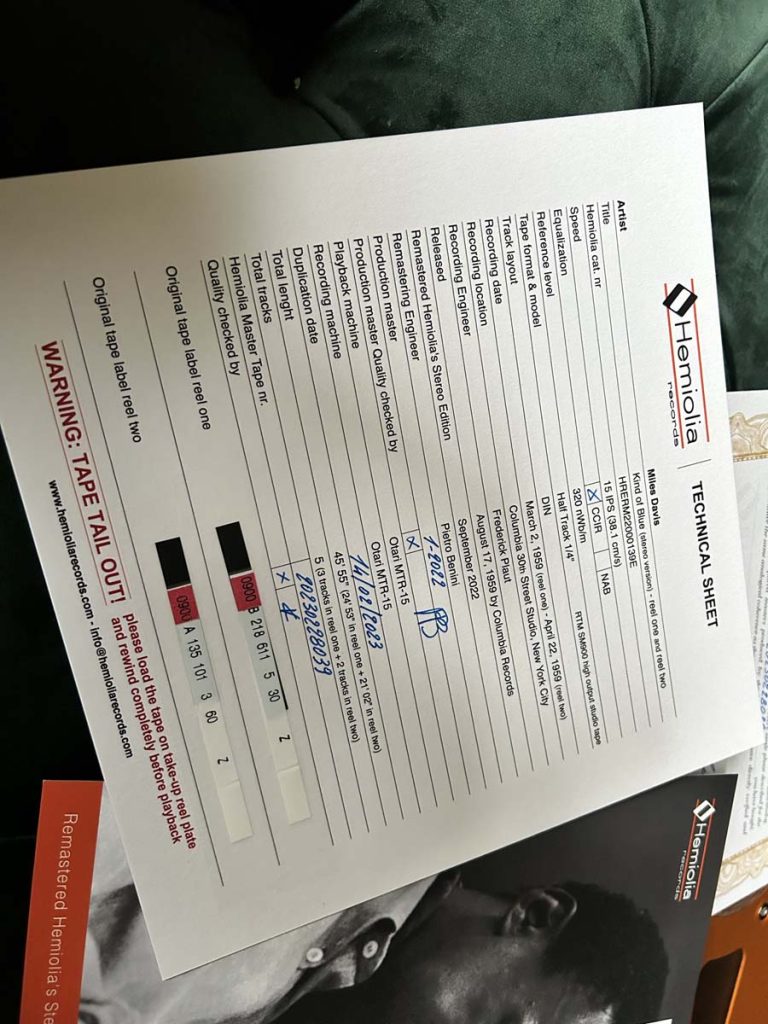
Kind Of Blue‘s 5 tracks are provided in this release by Hemiolia across two ¼”, 10” tapes running at 15ips(38cm/s). To best fit all 5 tracks Tape 1 has the March 2nd recordings of So What (9:26), Freddie Freeloader (9:49) and Blue in Green (5:38) with Tape 2 is the April 22nd All Blues (11:36), and Flamenco Sketches (9:26) totaling the nearly 46 minutes running time. Splitting across 2 tapes is the only way to achieve this length of album without cuts when running at this speed, but it does mean a lot of empty tape on reel 2. The tapes as usual are provided tails-out, so remember to load to the right and rewind before playing.
This 2022 Stereo remaster is by Pietro Benini of Hemiolia.
Rather than deep dive into each track and its musical merits, instead, let me share my thoughts on the overarching sonic attributes across the piece. Over the last couple of weeks I’ve been listening to single tracks and the album in full, across a number of formats, and across a couple of my systems, to build a good level of familiarity before applying a more critical listening in the last week or so on my main system of Tascam 32 and amplification shared between my Hegel 190 amplifier and Prima Luna Prologue 1 and both feeding my Amphion Argon3s’s. Listening to the UHQR vinyl is via my reference Origin Live and Gold Note chain into the Hegel 190/Prima Luna as before, so of course there is some variance, just as there is with the digital version via the Auralic Aries G1.
Putting the unavoidable variables aside, the UHQR is a truly wonderful production for me (as with previous UHQR work). The dynamics are wonderful, the music is incredibly vibrant and refined, and there is a strong, deep, but well-managed bass presence throughout. Out of the gate with So What you are transported to the late 50s. Chamber’s bass bobbing keenly along with Evans tiptoeing across the edges while Miles does what only he does – and so it goes for all 5 tracks with each player stepping forward at solo, but all the time anchored by the constructs assigned by Davis. Evans is up now, with Davis punctuating the modal river he’s navigating down, Chambers keeping the rudder centred all the way. Throughout the remainder of the work, we are enthralled in that head noddingly wonderful journey we listeners have embarked on and it is why this album stands tall to this day.
Now for the tape. Frankly, it’s incredible. For me, It’s immediately obvious that this remaster and this format is offering something sonically above and beyond; the impact, transparency, and emotional “grab” just exceeds any version I’ve heard before. One obvious difference between this and the UHQR version (system chain notwithstanding) is the bass. On the vinyl, there is a wonderful, deep, full, and warm bed of bass throughout and it’s incredible to listen to when listening in isolation to the vinyl. The bottom end overall feels weightier, and it allows horns to really register low and wide, and Paul Chambers Bass to get you in the guts…and then some.
The tape for me stands that bass down a notch, which in concert opens up the rest of the instruments to have increased presence and space, the whole album feels more focused and confident in the mid-range and with less weight in the bass to weigh it down so that it seems horns and piano notes soar around the room, the bass is tighter and just a little more foot-tappingly rhythmic. The dimensionality and staging are more expressed it seems, and the sense of temporal transportation back to 1959 seems all that more achieved. Brass, of both a trumpet and sax variety, just feels a bit more, well, real – less like I’m listening to my HiFi and more like I’m listing to Messrs Davis and co. in the spring of ‘59. (One can dream!)
What Hemiolia has done with Kind of Blue, where a few have already delivered incredible remasters, is just exceptional to my ears. Going back to the UHQR, it almost feels like the bass is a little overblown at times, a bit too weighty for the era, and lacking that aching clarity of brass – something I had never registered prior to hearing this version.
I’ll close on this; whichever version of Kind of Blue you listen to or own, you are listening to a one-in-a-million recording that brings together 6 of the best players in Jazz – period. The work is stunning, the Modal approach is breathtaking, and the music is a joy. There are no bad versions of this album – the music is just that good. What Hemiolia have done however, is take that diamond, breathe on it and give it a polish, and sit it “just so” in the sun at that magical golden hour allowing it to shine just right, have just that bit more transparency and with that, they have elevated it just that little (important) bit more.
Bravo! I really do hope more follow! I will be first in line – once I’ve saved up my pennies!
Miles Davis – Kind Of Blue 15ips/38cms is available direct from Hemiolia records on either CCIR or NAB EQ (7 days preparation time) equalisation for €696 + shipping (plus any required import fee). Currently, Hemiolia are unable to ship this product to the US.
Track listings and timing (across both tapes).
So What (9:26)
Freddie Freeloader (9:49)
Blues in Green (5:38)
All Blues (11:36)
Flamenco Sketches (9:26)
Associated review equipment – Tascam 32, Hegel 190 Amplifier, Prima Luna Dialogue Amplifier (for comparison), Amphion Argon 3s speakers, Graham Slee cabling from r2r to Amp, Tellurium Q Black II speaker cabling. Power by Titan Audio, Room treatment by GIK Acoustics, all equipment stands/racks by SolidSteel.

Alan McIntosh

















































